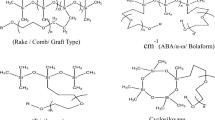Abstract
Thermal ageing of triacylglycerides (TAG) at high temperatures produces films which resist removal using aqueous surfactant solutions. We used a mass loss method to investigate the removal of thermally aged TAG films from hard surfaces using aqueous solutions of surfactants of different charge types. It was found that cationic surfactants are most effective at high pH, whereas anionics are most effective at low pH and a non-ionic surfactant is most effective at intermediate pH. We showed that the TAG film removal process occurs in several stages. In the first “lag phase” no TAG removal occurs; the surfactant first partitions into the thermally aged film. In the second stage, the TAG film containing surfactant was removed by solubilisation into micelles in the aqueous solution. The effects of pH and surfactant charge on the TAG removal process correlate with the effects of these variables on the extent of surfactant partitioning to the TAG film and on the maximum extent of TAG solubilisation within the micelles. Additionally, we showed how the TAG removal is enhanced by the addition of amphiphilic additives such as alcohols which act as co-surfactants. The study demonstrates that aqueous surfactant solutions provide a viable and more benign alternative to current methods for the removal of thermally aged TAG films.













Similar content being viewed by others
References
Raney KH, Benson HL (1990) The effect of polar soil components on the phase inversion temperature and optimum detergency conditions. J Am Oil Chem Soc 67:722–729
Miller CA, Raney KH (1993) Solubilization-emulsification mechanisms of detergency. Colloids Surf A 74:169–215
Chen B-H, Miller CA, Garrett PR (1997) Rates of solubilisation of triolein into non-ionic surfactant solutions. Colloids Surf A 128:129–143
Chen B-H, Miller CA (1998) Rates of solubilisation of triolein/fatty acid mixtures by non-ionic surfactant mixtures. Langmuir 14:31–41
Gotoh K (2005) The role of liquid penetration in detergency of long-chain fatty acid. J Surf Deterg 8:305–310
Alameda EJ, Rodriguez VB, Olea JN, Moreno RB, Borrego AG, Vaz DA (2009) Design of experiments to evaluate the detergency of surfactants on fatty soils in a continuous-flow device. J Surf Deterg 12:191–199
Alameda EJ, Rodriguez VB, Moreno RB, Olea JN, Vaz DA (2011) Fatty soils removal from hard surfaces in a clean-in-place system. J Food Proc Eng 34:1053–1070
Alameda EJ, Roman MG, Vaz DA, Perez JLJ (2012) Assessment of the use of ozone for cleaning fatty soils in the food industry. J Food Eng 110:44–52
Gillam NW (1949) Variation of chemical reactions with temperature during the oxidation and polymerization of fatty oils. Aust Chem Inst J Proc 19–36
Lewis WR, Quackenbush FW (1949) The use of the polarograph to distinguish between the peroxide structures in oxidized fats. J Am Oil Chem Soc 26:53–57
Hess PS, O’Hare GA (1950) Oxidation of linseed oil: temperature effects. Ind Eng Chem 42:1424–1431
Johnson OC, Kummerow FA (1957) Chemical changes which take place in an edible oil during thermal oxidation. J Am Oil Chem Soc 34:407–409
Blumenthal MM (1991) A new look at the chemistry and physics of deep-fat frying. Food Technol 45:68–71
Muizbelt WJ, Nielen MWF (1996) Oxidative crosslinking of unsaturated fatty acids studied with mass spectrometry. J Mass Spec 31:545–554
Tan CP, Che Man YB (1999) Differential scanning calorimetric analysis for monitoring the oxidation of heated oils. Food Chem 67:177–184
Tan CP, Che Man YB (1999) Quantitative differential scanning calorimetric analysis for determining total polar compounds in heated oils. J Am Oil Chem Soc 76:1047–1057
Choe E, Min DB (2007) Chemistry of deep-fat frying oils. J Food Sci 72:R77–R86
Kalogianni EP, Karapantsios TD, Miller R (2011) Effect of repeated frying on the viscosity, density and dynamic interfacial tension of palm and olive oil. J Food Eng 105:169–179
Hilditch T, Williams P (1964) The chemical constitution of natural fats, 4th edn. Chapman and Hall, London
Reid VW, Longman GF, Heinerth E (1967) Determination of anionic-active detergents by two-phase titration. Tenside 9:292–304
Tsubouchi M, Tanaka Y (1984) Determination of poly(oxyethylene) non-ionic surfactants by two-phase titration. Talanta 31:633–634
Salama IE (2011) Surfactant properties of corrosion inhibitors. PhD thesis, University of Hull, UK
Mukherjee P, Mysels KJ (1971) Critical micelle concentration os aqueous surfactant solutions. Nat Stand Ref Data Ser Nat Bur Stand, Washington DC
Guthrie JP (1978) Hydrolysis of esters of oxy acids: pKa values for strong acids; Bronsted relationship for attack of water at methyl; free energies of hydrolysis of esters of oxy acids; and a linear relationship between free energy of hydrolysis and pKa holding over a range of 20 pK units. Can J Chem 56:2342–2354
Acknowledgments
We thank Yorkshire Forward for funding.
Author information
Authors and Affiliations
Corresponding author
About this article
Cite this article
Dunstan, T.S., Fletcher, P.D.I. The Removal of Thermally Aged Films of Triacylglycerides by Surfactant Solutions. J Surfact Deterg 17, 899–910 (2014). https://doi.org/10.1007/s11743-013-1514-9
Received:
Accepted:
Published:
Issue Date:
DOI: https://doi.org/10.1007/s11743-013-1514-9




